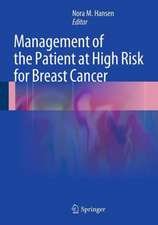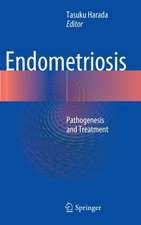The Male Factor in Human Infertility Diagnosis and Treatment: Studies in Fertility and Sterility, cartea 2
Editat de W. Thompson, R.F. Harrison, J. Bonnaren Limba Engleză Paperback – 5 oct 2011
Preț: 369.10 lei
Preț vechi: 388.52 lei
-5% Nou
Puncte Express: 554
Preț estimativ în valută:
70.63€ • 73.93$ • 58.78£
70.63€ • 73.93$ • 58.78£
Carte tipărită la comandă
Livrare economică 31 martie-14 aprilie
Preluare comenzi: 021 569.72.76
Specificații
ISBN-13: 9789401086691
ISBN-10: 9401086699
Pagini: 304
Ilustrații: 304 p.
Dimensiuni: 155 x 235 x 16 mm
Greutate: 0.43 kg
Ediția:1984
Editura: SPRINGER NETHERLANDS
Colecția Springer
Seria Studies in Fertility and Sterility
Locul publicării:Dordrecht, Netherlands
ISBN-10: 9401086699
Pagini: 304
Ilustrații: 304 p.
Dimensiuni: 155 x 235 x 16 mm
Greutate: 0.43 kg
Ediția:1984
Editura: SPRINGER NETHERLANDS
Colecția Springer
Seria Studies in Fertility and Sterility
Locul publicării:Dordrecht, Netherlands
Public țintă
ResearchCuprins
Section 1: Evaluation of the spermatozoa.- 1 A computerized technique for the measurement of sperm cell velocity: correlation of the results with in vitro fertilization assays.- 2 Automatic analysis of sperm characteristics by means of a microcomputer system.- 3 In vitro cross penetration testing in infertile couples.- 4 A new standardized in vitro penetration test (bovine) measuring the capacity of fertilization. I.- 5 A new standardized in vitro penetration test (bovine) measuring the capacity of fertilization. II.- 6 Penetration of zona-free hamster eggs by human spermatoza. Comparison of two methods.- 7 Reduced penetration of zona-free hamster ova by cryopreserved human spermatozoa.- 8 Effect of caffeine on human sperm penetration into zona-free hamster ova.- 9 The variability and clinical value of a heterologous ovum penetration test.- 10 Laser-induced stimulation of sperm motility in vitro.- 11 Time-sequential observation on human sperm penetration into zona pellucida-free hamster oocytes by scanning electron microscopy.- 12 Analysis of various experimental conditions on the rate of human sperm penetration into zona-free hamster ova.- Section 2 The Biochemistry of Gonadal Function.- 13 Levels of vitamin B12 and folic acid in seminal plasma from subjects with normal semen analysis and patients with idiopathic oligoasthenozoospermia.- 14 Functional role of relaxin in human seminal fluid.- 15 Hyperprolactinaemia and abnormal seminal cytology.- 16 Serum FSH and spermatogenesis.- 17 Response to FSH of human Sertoli cells in culture.- 18 Anaerobic urinary and prostatic bacteria, and prostatic biochemical markers in urine after prostatic massage of infertile men.- 19 Effects of bombesin on the pituitary response to TRH and LHRH in humans.- Section 3 Immunology and Male Reproduction.- 20 Characteristics of a monoclonal anti-human sperm antibody.- 21 Topographical analysis of the surface of human spermatozoa by means of monoclonal antibodies.- 22 Human seminal plasma proteins: identification and preliminary characterization of a human sperm coating antigen (h-SCA) protein in physiological and pathological conditions.- 23 Antigenicity of sperm cells after freezing and thawing.- 24 A radioimmunoassay for antisperm antibodies using 125I-labelled protein A.- 25 Human cervical response to artificial insemination.- Section 4 Medical Treatment of the Infertile Male.- 26 Kallman’s syndrome — sustained spermatogenesis three years after cessation of treatment.- 27 Effects of testosterone undecanoate on semen quality and sexual behaviour.- 28 Tamoxifen in the treatment of reduced semen quality: preliminary results.- 29 Tamoxifen in the management of male subfertility — a retrospective analysis.- 30 Increased sperm count in 41 cases of idiopathic normogonadotropic oligozoospermia following treatment with tamoxifen.- 31 Treatment of oligozoospermia with Chinese herb medicine.- 32 Bacterial contamination of semen of infertile couples and the effect of antibiotic treatment of semen quality and fertility.- Section 5 Surgical Treatment of the Infertile Male.- 33 Effects on semen parameters and pregnancy rate after occlusion of the spermatic vein in subfertile men with idiopathic varicocele.- 34 Varicocelectomy for oligozoospermia.- 35 Emission failure due to retroperitoneal lymphadenectomy: first report of a pregnancy after insemination of spermatozoa obtained by midodrin-induced retrograde ejaculation.- 36 Restoration of antegrade ejaculation following radical retroperitoneal lymphadenectomy.- 37 Transurethral resection of verumontanum forejaculatory duct stenosis and oligozoospermia.- 38 Results of microsurgical testicular autotransplantation in nine patients with high-lying undescended testis.- Section 6 Artificial Insemination.- 39 Echosonographic control of follicular growth in heterologous therapeutic insemination (AID).- 40 A comparison of fresh and frozen semen in AID practice.- 41 AID in the problem patient.- 42 Repeat pregnancies with AID.- 43 The post-insemination test in predicting the outcome of artificial insemination with husband’s semen.- 44 The relationship between the survival of human spermatozoa in culture medium and pregnancy rate.- 45 Duration of vitality and migrating ability of +4 °C cryopreserved human spermatozoa.- 46 Male sterility caused by anejaculation — aetiology diagnosis and treatment.- 47 Psychological patterns of AID-demanding marital couples.- 48 The complexity of psychological issues involved in artificial insemination by donor.- 49 Secrecy in the provision of artificial insemination by donor (AID).- Addendum to Section 1.- 50 Relationships between results of post-coital test and parameters of semen analysis.- Addendum to Section 2.- 51 Seminal plasma isoenzyme LDH-X values in extreme oligozoospermia.



















